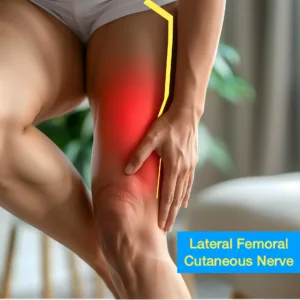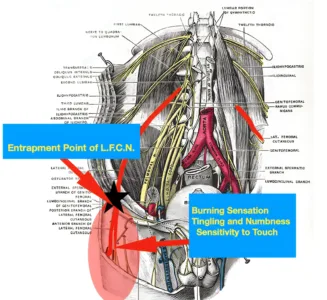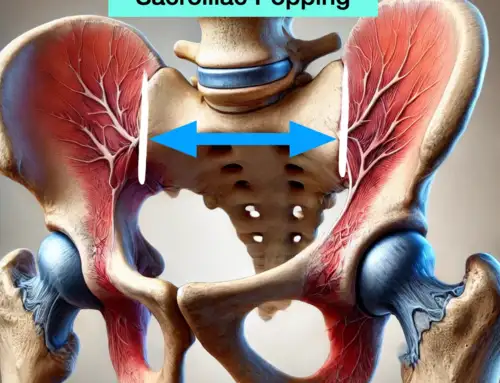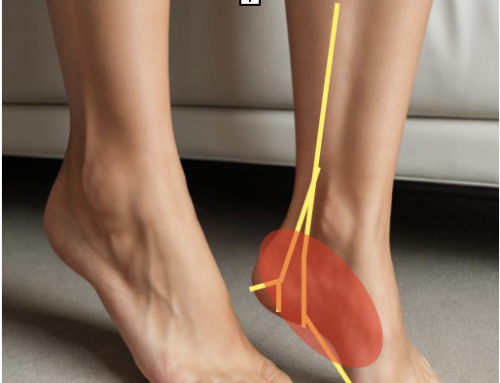Relieve Thigh Pain with Lateral Cutaneous Nerve Treatment!

Unlocking the Secrets of the lateral femoral cutaneous of the thigh.
As a seasoned expert in nerve entrapment, I have seen firsthand how this vital nerve impacts sensory functions and movement coordination. This cutaneous nerve of the thigh is a key player in our nervous system, influencing our overall health and well-being.
Anatomy
Unlocking the Mysteries of the Lateral femoral cutaneous nerve of the thigh.
The lateral cutaneous nerve, also referred to as the femoral cutaneous nerve, plays a vital role in sensation within the thigh area. Delving into its anatomy is key to grasping its function and potential implications.
Unveiling its intricate structure:
- Originating from the lumbar plexus, specifically branching off from L2 and L3 spinal nerves.
- Emerging between two muscles, namely the psoas major and iliacus, near ASIS.
- Journeying laterally across the inguinal ligament towards its destination in your thigh.
Tracing its origin and pathway:
- Stemming from branches within the lumbar plexus.
- Following a superficial path alongside blood vessels after emerging near ASIS.
- Branching out into smaller nerves that provide sensation to various areas on your outer thigh.
Interconnections with neighboring nerves:
- While primarily responsible for sensory innervation in specific regions of your thigh’s surface, it does interact with adjacent nerves.
- Notably linked with a branch of another significant nerve known as the femoral nerve for coordinated sensory input regulation in your leg.
Understanding these anatomical intricacies sheds light on how this particular nerve contributes to our body’s complex nervous system functions. In section [3], we will delve deeper into its pivotal role in both sensory perception and movement coordination.
Function
The nerve is a key player in both sensory perception and movement coordination. Delving into its function is crucial for grasping its importance within the nervous system.
Sensory Perception:
- The femoral nerve primarily innervates the skin on the outer side of the thigh, allowing us to sense touch, temperature, and pain in this area.
- Any issues with this nerve can lead to altered sensation or numbness along its distribution pathway.
Impact on Movement Coordination:
- While its main role lies in sensory functions, the femoral nerve indirectly influences movement coordination.
- By providing sensory feedback from our surroundings, it aids in maintaining balance during activities like walking or running.
- This feedback loop helps adjust posture and gait by coordinating muscle movements effectively.
Relationship with Muscles and Skin:
- Although not directly involved in motor control, disruptions within this nerve can affect nearby muscles indirectly.
- Compression or entrapment of the femoral nerve may result in muscle weakness due to decreased neural input.
- Changes in skin sensation caused by issues with this nerve can impact muscle activation patterns during movement.
Understanding these facets underscores how essential proper functioning of the femoral nerve is for overall mobility and sensory perception specifically related to your thighs’ outer side.
Common Conditions and Disorders
The femoral cutaneous nerve of the thigh is susceptible to a variety of conditions and disorders that can have a significant impact on daily life. Recognizing these common issues is crucial for prompt identification of symptoms, seeking appropriate treatment, and maintaining overall well-being.
Meralgia Paresthetica:
This condition arises when the lateral cutaneous nerve becomes compressed or entrapped, resulting in sensations such as pain, tingling, numbness, or burning in the outer thigh. Tight clothing, obesity, pregnancy, or repetitive activities that exert pressure on the nerve are often contributing factors.
Nerve Entrapment Syndromes:
Entrapment of the lateral cutaneous nerve at various points along its pathway can lead to discomfort. Common sites include those near the inguinal ligament by the hip joint and as they pass through an opening known as the anterior superior iliac spine (ASIS). These entrapments may manifest similar symptoms to meralgia paresthetica but necessitate specific diagnostic tests for accurate identification.
Peripheral Neuropathy:
Damage to peripheral nerves throughout the body can affect sensory function in multiple areas, including the thighs. Diabetes mellitus frequently causes peripheral neuropathy, which may result in impairment of both motor and sensory functions.
Post-Surgical Complications:
Procedures involving structures around the thigh region, like hernia repairs or hip replacements, carry a risk of damaging the nerves of the upper leg. This damage can lead to post-operative complications such as altered sensation or persistent pain in this area.
Trauma:
Direct trauma to your outer thigh could potentially injure this delicate nerve, causing localized pain and sensory disturbances.
Diagnosis:
Healthcare professionals typically conduct a comprehensive physical examination and a medical history assessment to diagnose accurately.
- Detailed descriptions of patient symptoms aid in identifying potential causes.
- Diagnostic tests like nerve conduction studies, electromyography (EMG), or imaging techniques such as ultrasound may be utilized for confirmation diagnosis and assessing the severity of nerve damage.
- Palpation of the nerve on the inside portion of the ASIS can recreate symptoms and confirm diagnosis.
Impact on Overall Health:
Experiencing issues with this nerve can significantly impact your quality of life. Chronic pain, altered sensation levels, and mobility limitations can hinder daily activities and mental well-being. Seeking prompt treatment is crucial for managing symptoms effectively and preventing complications. Consulting healthcare professionals is essential if you have persistent symptoms in your thighs or suspect problems with your cutaneous nerve. Early intervention can lead to better outcomes and improve overall health.
Treatment Options for Disorders
Section 5: Effective Treatments
Navigating the treatment options available for disorders of the thigh can be overwhelming. As an expert in nerve entrapment, I am here to provide you with valuable insights into some common and effective treatment strategies that can help alleviate symptoms and enhance overall well-being.
- Conservative management approaches:
- Physical therapy: Engaging in a targeted exercise regimen can bolster the muscles surrounding the affected area, enhancing stability and alleviating pressure on the nerve.
- Medications: Nonsteroidal anti-inflammatory drugs (NSAIDs) may be recommended to mitigate pain and inflammation linked to nerve compression.
- Rest and activity modification: Steering clear of activities that worsen symptoms can offer relief while allowing time for healing.Surgical interventions:
If conservative treatments prove ineffective or if there is substantial nerve damage present, surgical intervention may be warranted. Some surgical options include:
- Decompression surgery: This procedure entails releasing any structures compressing the nerve, such as tight fascia or scar tissue.
- Nerve release surgery: Surgeons meticulously free up any adhesions or entrapments along the pathway of the nerve to restore normal function.
Importance of physiotherapy and rehabilitation:
Physiotherapy is essential for recovery post-surgery or during conservative treatment. It includes strengthening exercises, stretching techniques, and manual therapies to restore optimal function. Consulting with a specialist in peripheral nerves is crucial as each case is unique. They will assess your condition and recommend suitable treatment options based on their expertise. Early diagnosis and timely intervention are key to better outcomes. Seek medical attention promptly if you have persistent symptoms or concerns about your nerve health.
Preventive Measures and Healthy Practices
Optimal Nerve Health Practices
Taking care of Neuraglia in the thigh is vital for your overall well-being. By incorporating key practices and healthy habits, you can greatly lower the chances of nerve-related issues. Here are some essential tips to keep your nerves healthy:
Regular Exercise:
Regular physical activity enhances blood flow, crucial for optimal nerve function. Target thigh and hip muscles to support reduce strain on the neurology.
Correct Posture:
Improve your posture to relieve nerve pressure. Avoid slouching or crossing legs for long periods to prevent thigh nerve compression. Your body will thank you!
Ergonomic Workstation Setup:
Optimize your desk setup for comfort and productivity. Invest in an adjustable chair with lumbar support and position your computer screen at eye level to reduce strain on your lower back and legs.
Weight Management:
Carrying extra weight puts strain on different areas of your body, such as the nerves in your thighs. Keep a healthy weight by eating well and staying active to relieve this pressure on your nerves.
Stretching Routine:
Enhance your flexibility and ease muscle tension by incorporating daily stretching exercises targeting the nerve.
Avoid Prolonged Sitting or Standing:
Extended periods of sitting or standing without breaks can lead to compression of nerves supplying sensation to different areas, including those in the thigh region. Take short breaks every hour to stretch or walk around if you have a sedentary job.
Regular Check-ups:
Schedule routine appointments with healthcare professionals specializing in nervous system disorders or orthopedics to monitor any changes related to nerve health.
Lifestyle Adjustments:
Smoking and excessive alcohol can harm your nerves. Quitting smoking and moderating alcohol intake will boost nerve health. Prioritize prevention to maintain optimal leg function and reduce risks of related issues. Enjoy improved leg functionality with daily preventative care strategies.
Latest Research and Developments
Maintaining Optimal Nerve Health: Expert Tips
As someone well-versed in nerve entrapment, I know the significance of keeping your nerves healthy. The lateral cutaneous nerve of the thigh is vital for sensory functions and movement coordination. To ensure its well-being, here are some expert tips on preventive measures and healthy practices to incorporate into your daily routine:
Manage a Healthy Weight:
Excess body weight can exert unnecessary pressure on nerves, including the femoral cutaneous nerve of the thigh. Maintaining a healthy weight through regular exercise and a balanced diet can lower the risk of nerve compression.
Prioritize Good Posture:
Poor posture can lead to muscle imbalances and increased pressure on various nerves, including those in your thighs. Be mindful of how you sit and stand to avoid straining your nerves.
Embrace Regular Stretching:
Including stretching exercises in your daily routine enhances flexibility and reduces muscle tension that may contribute to nerve compression. Focus on stretches targeting muscles around the thigh area.
Avoid Prolonged Sitting or Standing:
Sitting or standing for long periods can put pressure on important nerves, such as the lateral cutaneous nerve of the thigh. To protect this vital nerve, make sure to take breaks every hour to stretch and switch positions.
Wear Comfortable Clothing:
Tight clothing around the waist or thighs can compress nerves over time, leading to discomfort or pain in these areas. Opt for loose-fitting attire that allows unrestricted movement and minimizes irritation.
Master Proper Lifting Techniques:
When lifting heavy objects, using the correct form is essential to prevent back injuries and potentially safeguard other parts, like your thighs’ nerves, from harm.
Regular Check-ups with Neurology Specialists:
Keep your lateral cutaneous nerve of the thigh healthy and prevent entrapment issues by proactively scheduling check-ups with neurology specialists. They will tailor prevention strategies specifically for you, helping you maintain optimal nerve function. Prioritize integrating healthy habits into your daily routine to stay ahead of potential problems and ensure long-term nerve health.
Reach out to Dr. Dean (sports doctor) in California by texting (best), calling 323-354-6077, or emailing at drjustindean@gmail.com
Our editorial practices include evidence-based practices, interventions, and recommendations.
References





